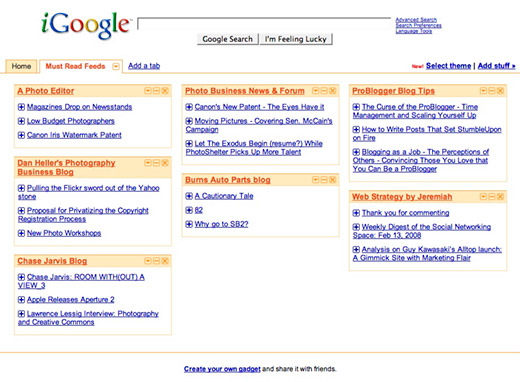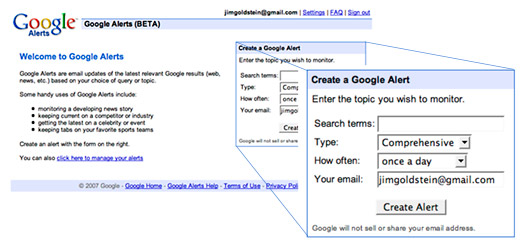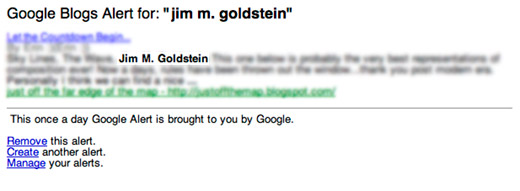I don’t talk about it much, but in addition to photography I’m also a web strategist with over 10 years of web marketing experience. On a day to day basis I’m constantly exploring and using a variety of web services and technologies that enable me to more optimally market my photography, track trends and track instances of copyright infringement. I’ve begun to take some of the core services and technologies I use on a daily basis for granted, but a recent conversation with a friend refreshed my perspective on this. As a result I wanted to take advantage of my recent epiphany and share 5 services/technologies I think are invaluable to photographers marketing their work online.
5. Google Reader
This online and free RSS reader is extremely well designed and easy to use. First and foremost RSS readers in general are a great way to access and read articles quickly minimizing the time it takes to open and load web sites individually. At a minimum I would recommend using this RSS reader if not any reader for that matter to improve ones productivity. One nice thing I finally took the time to do is to create a custom tab to display the top 7 sites I like to keep tabs on. The end result is a fast way for me to check the latest additions to 7 sites in one quick glance.

4. Del.icio.us
Del.icio.us is a social bookmarking site. Rather than keeping your bookmarks tied to a local machine you can save your favorite bookmarks to this web site. If you’re on a machine different than your own you can login and access your bookmarks anywhere. In addition you can tag bookmarks, add friends to your network to view and share recent bookmarks and you can also employ widget functionality on your blog to display recent pages that you’ve bookmarked. At a minimum I use this to consolidate and improve the searchability of my bookmarks. The site has been invaluable as I move back and forth between different machines.
3. Flickr
For all its flaws I’m still a believer in Flickr. Why? Pure and simple ease of use and traffic. The site is dirt simple to use… sometimes to its detriment as people pilfer photos from the site, but as a photo publisher/fan you can’t beat the ease of viewing and searching photos. This leads to my point about traffic on Flickr. Flickr is the 800lb gorilla of image sharing sites. With 2+ billion images in their system a lot of eyes are drawn to the site. As a marketer there is a saying… “fish where the fish are”. Casting a line out to see if you get any bites for sales/licensing opportunities is hit or miss, but as time has shown it does happen. My recommendation to fellow photographers on Flickr… avoid giving your work away for free and learn when to cut your losses with someone inquiring about using your work. If someone is contacting you about using your image it has value to the person, recognize this and negotiate.
2. Technorati
Technorati is a blog search engine. It’s a great resource to look for content, track blogs you like, track your blog authority, fans of your blog and set up keyword based Watchlists. Technorati is but one of many blog search engines, but it is one that is particularly well known. If you’re putting your photographic work online it pays to use the service to track references of your name and/or domain. In the process you may just discover your images being used without consent or in ways you might not approve of.
1. Google Alerts
Similar to Technorati Watchlists I’ve set up Google Alerts for my name and my domain name. Google Alerts then sends me regularly scheduled emails identifying new content including my specified search terms. Links are provided in the email to click through to see the page containing the specified search terms. This has been the number one tool I’ve used to identify inappropriate use of my photography online.

Google Alert Sign-Up Page

Google Alert Email
[tags]Google, alert, Technorati, services, technology, photographer, photography, photo, copyright, infringement, tracking, Flickr, RSS, reader, Del.icio.us[/tags]

Forgive me, Jim, for I am about to post a tongue-in-cheek response 🙂
I am your worst nightmare. If everyone had my Internet habits, there would be no such profession as web marketing. I religiously block all advertising and tracking sites from my browser and generally go on for weeks without ever seeing an ad. I use the rudimentary RSS reader built into FireFox to keep track of a couple of blogs, and I visit specific web sites where I know I can find reliable information from unbiased users.
To that effect, I do not use any of the 5 technologies you listed. Considering your subject line, this may reinforce some people’s opinion that I’m not truly a photographer 🙂
Lest I be considered a luddite, I have been an IT professional for over 15 years and manage an IT group for a large company so I’m well aware of the technology. I’m just very careful about letting it take over my off-line life.
As tools go, my process is divided into two phases: the unplugged, and the wired. I could do without the latter but never without the former. My inspiration is directly linked to physically being off the grid.
If I had to rate my top technologies every photographer should use, well they might look more like this:
1) Brain, Soul, Legs, Arms: Some of the best free tools available (no download necessary). Too bad many people don’t take the time to master the power-user features of their own hardware and software.
2) Books: Great source of knowledge and inspiration, fully portable, no batteries required.
3) Capable vehicle: Capable as in can get you to where the trails begin.
4) Capable camera gear: Capable as in meets your usage and quality requirements/limitations.
5) Decent computer and Photoshop: this is the “wired” part of my process. I enjoy it tremendously.
Interesting as they are, I cannot recall a time in which blogging or related tools were in any way essential to my photography. For general socializing and exchanging information – certainly! Could I live without it should it all were to go away tomorrow? Easily!
Am I a dying breed?
Guy
Guy you are by no means my worst nightmare nor any less a photographer for choosing not to pursue online services or technologies as outlined in this post. Everyone has their comfort zone and every photographer has different photographic goals. Strangely most of the people that I know that pride themselves on not being online are those that work in IT as a profession. Whether or not this backlash is because of their daily exposure to the online environment I’m not sure, but it sure seems as though that is the case.
I think where I’m going with my post, that isn’t addressed in your response (tongue-in-cheek or not), is to focus on increasing efficiency and awareness. For most online tools I’m sure you could trace back their roots to an offline equivalent, but their benefit almost always fall back to speed, efficiency and time saving. If you choose to walk or ride a bike versus driving a car you’re accomplishing the same task, but are you making the most of your time to do everything you want? The same question holds true for using these tools and even the editing software you choose to use
To go right back at you… why bother with a camera when you can bring canvas, paints and brushes? You’re still able to enjoy the outdoors, capture a scene as seen and can do so in a time frame that is much slower. I know you shoot film and digital and I know you put your work online. It’s your prerogative how far you embrace that digital technology and leverage the tools available to you. The question I would pose is what do you want out of your photographic efforts and how are you going to engage people to achieve that? If engaging an audience of viewers isn’t a priority then ignore these recommendations. If engaging an audience is necessary to achieve your goals then its in your best interest to explore current trends.
Funny thing Guy is that not everyone was on board with computers and Photoshop several years ago and many still are not. Has that choice helped further the endeavors of those photographers? Most would say no. The question I pose to you and anyone else in a similar mindset on this topic, “Are the choices you’re choosing helping to further your photographic endeavors?”
Now to clarify I’ve never said that these tools are essential merely invaluable. Even if you never choose to use these tools I do hope you explore their use. You’ll never know what you’re missing if you don’t take the time to look.
Good thoughts, Jim!
I do not discriminate between photography and painting in the artistic sense. I am simply more adept at using one set of tools vs. the other, and the camera is a more suitable companion for the locations and activities I like to pursue. If I could paint like Bierstadt or Moran I may never touch a camera again.
Of course, like many other things, this is all about balance and we each set the bar differently. I just found it amusing that I am apparently so out of touch that I do not use a single one of these services.
Obviously my goal is to present and share my work and obviously some of these tools are more efficient at “blasting” out the word, but let me turn this around your way again: how much does context matter? Do you take an image or portfolio found on Flickr as seriously as on a tastefully/personally-designed web site? I have to admit I don’t. Most of these sites feel exceedingly competitive rather than inspirational. Is it still about the art or about trophy hunting? Is it about stirring souls or about ratings? Sistine Chapel or Hollywood?
Yes, I do want to share my work but more importantly I want to share the reverence, the emotion, the the experience. Where do these fit into mass media? How much are we compromising by maximizing audience at the expense of creating a unique, holistic experience?
Guy
Pingback: Photo News Today » Blog Archive » 5 Services/Technologies Every Photographer Should Be Using
Guy actually I think you have one fatal flaw in your read of this… this isn’t about “blasting” out. It’s about keeping an eye open and listening for conversations. Whether you recognize it or not blogs are about conversations. Our exchange here is a perfect example of that. Every tool/technology I referenced in this post is highlighted as a way to extend the reach a photographer has to view and hear what is going on around them in real time.
“how much does context matter?”
Do you take a photo on a black wall differently than on a white wall? Do you take a photo in one gallery more seriously than another? To your earlier point… an image if effective strikes a nerve with a viewer. The environment or surroundings to that image can have an impact, but at its core if the image is of quality is should have the same effect on the viewer no matter what. It’s rather pretentious to think that because an image is in one location versus another that it is less worthy of ones viewing.
As for competition versus inspirational… this is a topic of discussion unto itself. This comes down to personal philosophy and maturation as an artist. But one shouldn’t confuse this with the effort to reach a new audience. Fishing where the fish are is not a reflection of artistic integrity… its a reflection of awareness of your surroundings and exposing others of varying background to your vision of the world.
I think what question Guy was posing about Flickr is about a branding choice: sort of like would Versace rather release their latest at Wal-Mart or their own boutique? there’s nothing wrong with either choice, but there is different clientele. Depending on one’s goals, they might not want to reach a certain market segment.
Wow, Richard almost stole my thunder 🙂
“Do you take a photo on a black wall differently than on a white wall? Do you take a photo in one gallery more seriously than another?”
Yes! Absolutely!
Can you compare standing in front of an original Rembrandt in a museum to seeing a Thomas Kinkade poster at Target? Both are the works of extremely talented artists but the experiences are worlds apart.
I think the basic premise is that there’s a distinction, however hard to qualify, between treating art as an elevated concept vs. a common commodity to be lumped with 2 billion others like it in the hope that it will reach/sell more.
It’s a compromise every artist must decide for themselves and accept the consequences. I’m not making a judgement on either approach. My point is that reaching the largest audience is not the one goal to trump all others.
If I could have one of my works displayed in a back room of the Smithsonian vs. my entire portfolio lumped into the poster rack at a big-box store, personally I would go with the former and I honestly believe it would a better vehicle to reach the right audience (for me) with the right message (for me).
Guy
All points above are valid, different paths to the same horizon. I think that the difference could be akin to “one hit wonder” bands and, say, Elvis. Take the fast route, get recognized, make money then be forgotten. Alternatively, slowly build up recognition, become Known, then make money.
Guy to be clear here we need to differentiate the issues… efficiency vs. branding. There are two different discussions intermingling.
The one recommendation that we seem to be centering around is using Flickr. The efficiency gain (that is still debatable)is the ease of placing photos online and essentially reaching out to new publishers and generating sales opportunities.
Using Flickr to reach out to others does not necessarily equate to an abandonment of brand development or brand placement. As an artist Flickr can just as easily be used to create a mini-portfolio as it can to create a weekend trip photo sharing set. The goals and purposes are different and clearly can impact the brand one develops for themselves. Again is Flickr for everyone no, but if you’re interested in developing an audience that would otherwise be unable to find you then it provides value. Does that offset the perception of deteriorating your brand? Don’t answer that yet.
Lets first address the idea that Flickr a low brow “Target” or “Wal-Mart” environment. Flickr is used by two key audience types:
1) Photo enthusiasts
2) Photo buyers
a. consumers
b. publishers
Photo enthusiasts have developed a passion for photography and are sharing images, looking to improve, networking with photographers they like, etc.
Photo buyers are often photo enthusiasts, who cover a lot of different demographics, that enjoy an image they view so much they want to buy a print.
Publishers have developed into an unintended audience of users at Flickr and are are creative agencies, papers, magazines, online publishers, manufacturers, etc.
So back to the concept of efficiency… Are these audience types at Flickr on your radar as you market and sell your photography? Is so how are you currently reaching your target audience? How much time and money do you spend to reach them? These are some what rhetorical quesitons. The $64,000 question is how much does that translate to lost time for you in the pursuit of your art or the pursuit of sales?
Now to the conversation of Brand…
Does Flickr diminish the Brand of an artist? This is really subjective and my personal opinion is…
yes if you solely rely on Flickr to market your work. If Flickr is used as an extension of your primary web marketing channel namely your web site then… no. When an individual views your Flickr profile they’ll be able to peg you, your brand and the quality they can expect from you as photographer based on what information you provide. Your profile is your easiest way to bridge people from the mega-directory of images that Flickr is, to the destination you’re aiming to get them to in the first place.
There are other creative ways to leverage Flickr to your advantage, but this reply was long enough as it is. I whole heartedly agree that developing, maintaining and protecting ones brand is key, but this is a different facet of the conversation that first started around efficiency.
Pingback: Saturday Links Fever [2008-02-16] at All Day I Dream About Photography
Pingback: Link Roundup 02-16-2008
Hi Jim,
Nice write up. I thought I’d expand the list a little with some of the tools that I find valuable in my day to day operations.
… blah
it’s 3:30am … forgot the link 😉
http://nine2fivephotography.com/blog/archives/31-A-Few-More-Services-To-Check-Out.html
-Dez
Intersting article & follow up, thanks Jim
I have seen some pretty darn good work on Flickr. Just because it is on Flickr doesn’t really make me value the work any less personally. But it is mixed in a sea of images that makes it difficult to find for one thing.
Thanks for the tip on the Google Alert item Jim. I actually use it for another subject, and never thought of using it to hunt down possible copyright issues.